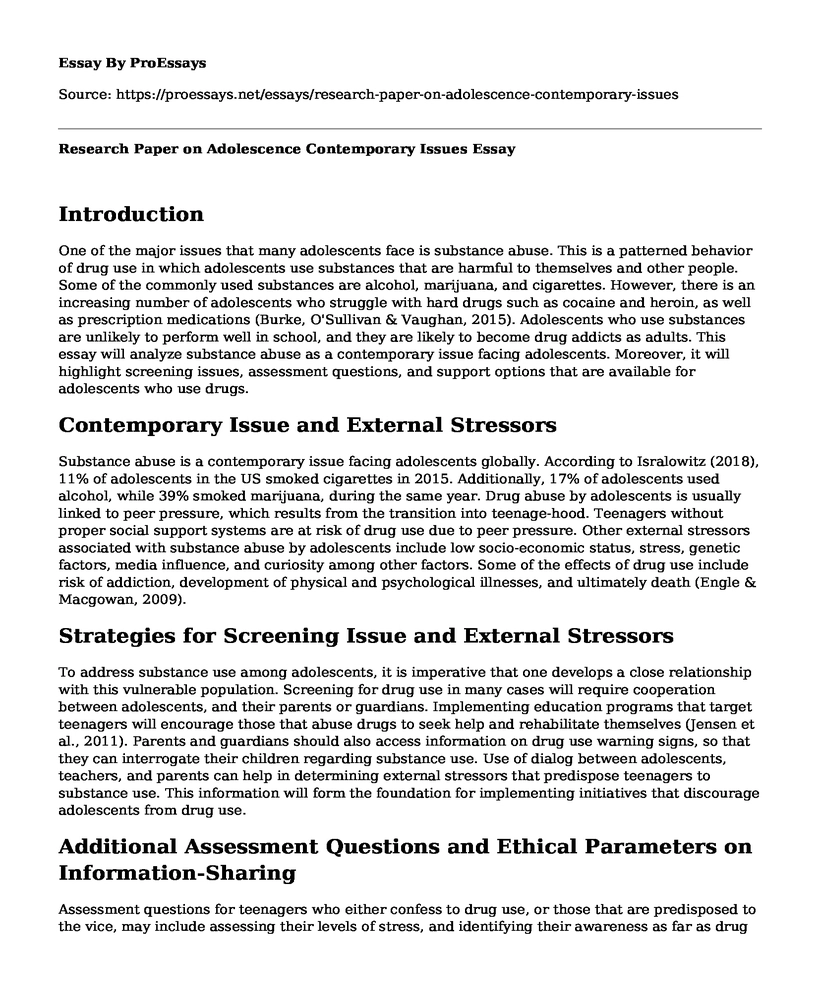Introduction
One of the major issues that many adolescents face is substance abuse. This is a patterned behavior of drug use in which adolescents use substances that are harmful to themselves and other people. Some of the commonly used substances are alcohol, marijuana, and cigarettes. However, there is an increasing number of adolescents who struggle with hard drugs such as cocaine and heroin, as well as prescription medications (Burke, O'Sullivan & Vaughan, 2015). Adolescents who use substances are unlikely to perform well in school, and they are likely to become drug addicts as adults. This essay will analyze substance abuse as a contemporary issue facing adolescents. Moreover, it will highlight screening issues, assessment questions, and support options that are available for adolescents who use drugs.
Contemporary Issue and External Stressors
Substance abuse is a contemporary issue facing adolescents globally. According to Isralowitz (2018), 11% of adolescents in the US smoked cigarettes in 2015. Additionally, 17% of adolescents used alcohol, while 39% smoked marijuana, during the same year. Drug abuse by adolescents is usually linked to peer pressure, which results from the transition into teenage-hood. Teenagers without proper social support systems are at risk of drug use due to peer pressure. Other external stressors associated with substance abuse by adolescents include low socio-economic status, stress, genetic factors, media influence, and curiosity among other factors. Some of the effects of drug use include risk of addiction, development of physical and psychological illnesses, and ultimately death (Engle & Macgowan, 2009).
Strategies for Screening Issue and External Stressors
To address substance use among adolescents, it is imperative that one develops a close relationship with this vulnerable population. Screening for drug use in many cases will require cooperation between adolescents, and their parents or guardians. Implementing education programs that target teenagers will encourage those that abuse drugs to seek help and rehabilitate themselves (Jensen et al., 2011). Parents and guardians should also access information on drug use warning signs, so that they can interrogate their children regarding substance use. Use of dialog between adolescents, teachers, and parents can help in determining external stressors that predispose teenagers to substance use. This information will form the foundation for implementing initiatives that discourage adolescents from drug use.
Additional Assessment Questions and Ethical Parameters on Information-Sharing
Assessment questions for teenagers who either confess to drug use, or those that are predisposed to the vice, may include assessing their levels of stress, and identifying their awareness as far as drug use and rehabilitation opportunities are concerned. Nurses may conduct these discussions confidentially with teenagers, since they are likely to open up in the absence of their parents and guardians. However, nurses are required to inform parents or guardians on issues relating to drug use by adolescents, especially if they seek treatment. This is because legal guardians require to give consent before their children are treated and rehabilitated.
Support Options for Adolescents with External Stressors
There are several support options that are available for adolescents who engage in substance use. There are recovery programs that entail therapy that is geared towards assisting teenagers to embrace lifestyle choices which reduce risk of drug use (Jensen et al., 2011). There are also treatment interventions that may include medication, which are necessary to help patients recover from substance use. It is imperative that affected patients receive social support from their families and peers, for them to make a full recovery. Strategies such as group therapy may be used to bring on board family members and peers, to assist adolescents recover from drug use (Engle & Macgowan, 2009).
Conclusion
In summary, substance abuse is a major problem facing adolescents, and some of the risk factors associated with drug use include low socio-economic status, peer pressure, stress and media influence among others. Since drug use harms victims physically and psychologically, nurses should be at the forefront in educating teenagers on dangers of drug use. Patients may require medication and therapy to overcome substance abuse. However, due to legal reasons, parents and legal guardians should be involved in the rehabilitation and treatment process, since their consent is required by law.
References
Burke, P. J.; O'Sullivan, J. & Vaughan, B. L. (2015). "Adolescent substance use: brief
interventions by emergency care providers". Pediatrics Emergency Care. 21 (11): 770-6. Retrieved from https://www.ncbi.nlm.nih.gov/pubmed/16280955
Engle, B. & Macgowan, M. J. (2009). "A Critical Review of Adolescent Substance Abuse
Group Treatments"; Journal of Evidence-Based Social Work. 6 (3): 217-243. Retrieved from https://www.ncbi.nlm.nih.gov/books/NBK78439/
Isralowitz, R. (2018). Drug use: a reference handbook. Santa Barbara, Calif.: ABC-CLIO
Jensen, C. D.; Cushing, C. C.; Aylward, B. S.; Craig, J. T.; Sorell, D. M. & Steele, R. G. (2011).
"Effectiveness of motivational interviewing interventions for adolescent substance use behavior change: A meta-analytic review"; Journal of Consulting and Clinical Psychology. 79 (4): 433-440. Retrieved from https://www.ncbi.nlm.nih.gov/pubmed/21728400
Cite this page
Research Paper on Adolescence Contemporary Issues. (2022, Nov 11). Retrieved from https://proessays.net/essays/research-paper-on-adolescence-contemporary-issues
If you are the original author of this essay and no longer wish to have it published on the ProEssays website, please click below to request its removal:
- The Impact of Literacy in Poverty Alleviation - Research Paper
- Paper Example on Law Enforcement: Regulation and Control of Drugs
- Alcohol Abuse: A Global Epidemic - Essay Sample
- Gang Activity: US & EU Responses Based On Prevention, Intervention & Suppression - Essay Sample
- Essay Example on White Privilege: Similar to Male Privilege But Not Easily Acknowledged
- Essay Example on Ruby Bridges: Religion & Civil Rights Movement
- Paper Example on Family Struggles with Alcohol Addiction: Effects on All Involved







